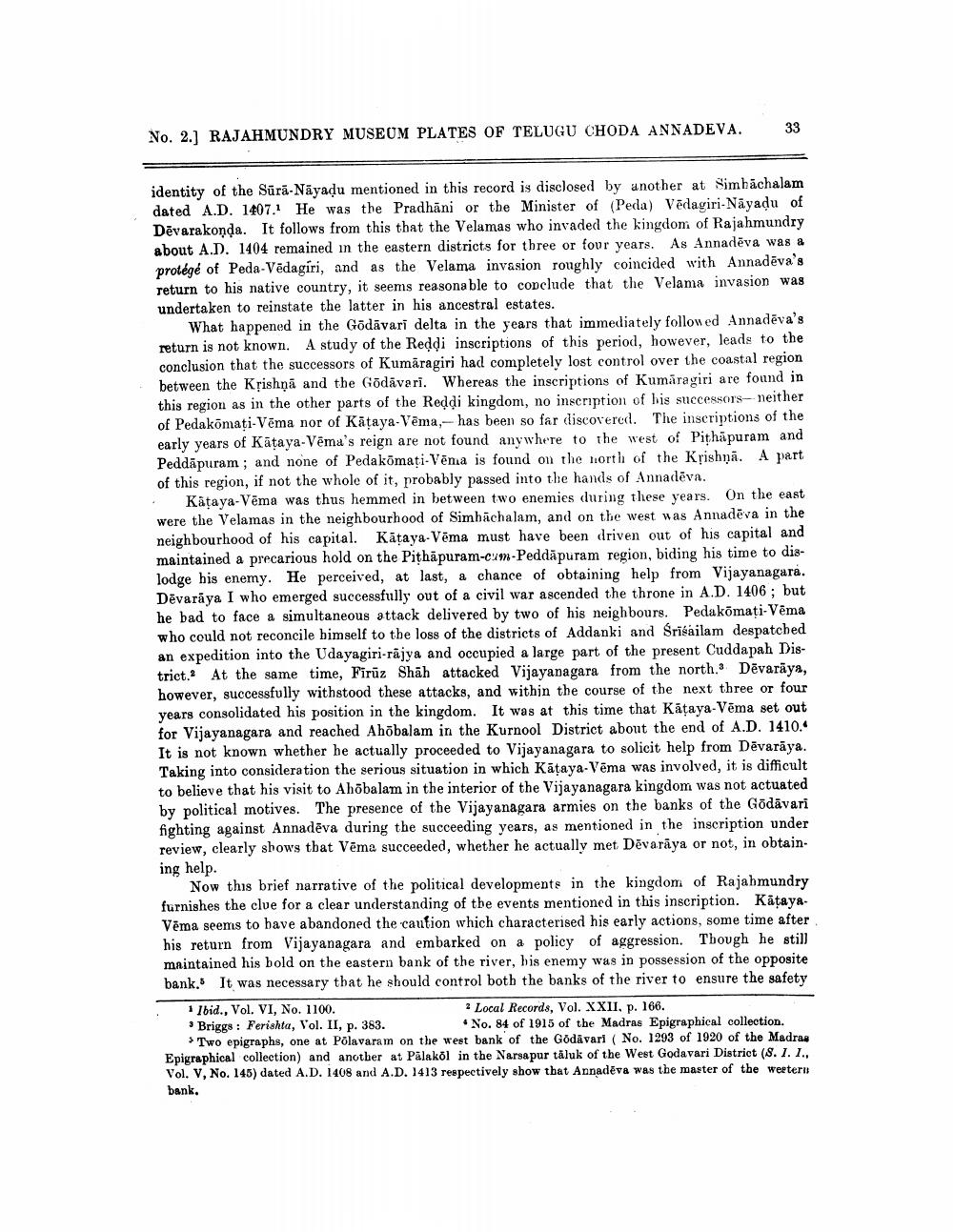________________
No. 2.) RAJAHMUNDRY MUSEUM PLATES OF TELUGU CHODA ANNADEVA.
33
identity of the Sūrā-Nāyadu mentioned in this record is disclosed by another at Simhāchalam dated A.D. 1407. He was the Pradhāni or the Minister of (Peda) Vēdagiri-Nāyadu of Dēvarakonda. It follows from this that the Velamas who invaded the kingdom of Rajahmundry about A.D. 1404 remained in the eastern districts for three or four years. As Annadēva was a protégé of Peda-Vēdagiri, and as the Velama invasion roughly coincided with Annadēva's return to his native country, it seems reasonable to conclude that the Velama invasion was undertaken to reinstate the latter in his ancestral estates.
What happened in the Gödāvari delta in the years that immediately followed Annadēva's return is not known. A study of the Reddi inscriptions of this period, however, leads to the conclusion that the successors of Kumāragiri had completely lost control over the coastal region between the Krishņā and the Gõdāvari. Whereas the inscriptions of Kumāragiri are found in this region as in the other parts of the Reddi kingdom, no inscription of his successors- neither of Pedakòmaţi-Vēma nor of Kāțaya-Vēma,- has been so far discovered. The inscriptions of the early years of Kāțaya-Vēma's reign are not found anywhere to the west of Pithāpuram and Peddapuram ; and none of Pedakòmati-Vēma is found on the north of the Krishņā. A part of this region, if not the whole of it, probably passed into the hands of Annadēva. . Kataya-Vēma was thus hemmed in between two enemies during these years. On the east were the Velamas in the neighbourhood of Simbachalam, and on the west was Annadēva in the neighbourhood of his capital. Kātaya Vēma must have been driven out of his capital and maintained a precarious hold on the Pithapuram-cum-Peddapuram region, biding his time to dislodge bis enemy. He perceived, at last, a chance of obtaining help from Vijayanagara. Dēvarāya I who emerged successfully out of a civil war ascended the throne in A.D. 1406; but he bad to face a simultaneous attack delivered by two of his neighbours. Pedakòmați-Vēma who could not reconcile bimself to the loss of the districts of Addanki and Srisailam despatched an expedition into the Udayagiri-rajya and occupied a large part of the present Cuddapah District. At the same time, Firüz Shāh attacked Vijayanagara from the north. Dēvarāya, however, successfully withstood these attacks, and within the course of the next three or four years consolidated his position in the kingdom. It was at this time that Kāțaya-Vēma set out for Vijayanagara and reached Ahõbalam in the Kurnool District about the end of A.D. 1410. It is not known whether he actually proceeded to Vijayanagara to solicit help from Dēvarāya. Taking into consideration the serious situation in which Kataya Vēma was involved, it is difficult to believe that his visit to Ahobalam in the interior of the Vijayanagara kingdom was not actuated by political motives. The presence of the Vijayanagara armies on the banks of the Godavari fighting against Annadēva during the succeeding years, as mentioned in the inscription under review, clearly shows that Vēma succeeded, whether he actually met Dévarāya or not, in obtaining help.
Now this brief narrative of the political developments in the kingdom of Rajahmundry furnishes the clve for a clear understanding of the events mentioned in this inscription. Kātaya. Vēma seems to have abandoned the caution which characterised his early actions, some time after his return from Vijayanagara and embarked on a policy of aggression. Though he still maintained his bold on the eastern bank of the river, his enemy was in possession of the opposite bank. It was necessary that he should control both the banks of the river to ensure the safety 1 Ibid., Vol. VI, No. 1100.
? Local Records, Vol. XXII, p. 166. Briggs : Ferishta, Vol. II, p. 383.
No. 84 of 1915 of the Madras Epigraphical collection. * Two epigraphs, one at Polavaram on the west bank of the Godavari ( No. 1293 of 1920 of the Madras Epigraphical collection) and another at Palakol in the Narsapur tāluk of the West Godavari District (S. 1. 1., Vol. V, No. 145) dated A.D. 1408 and A.D. 1413 respectively show that Annadeva was the master of the weetern bank,




